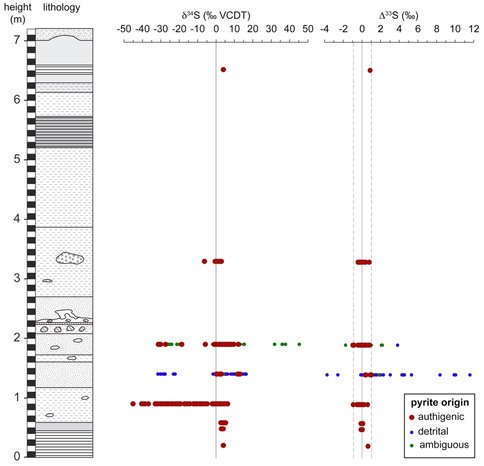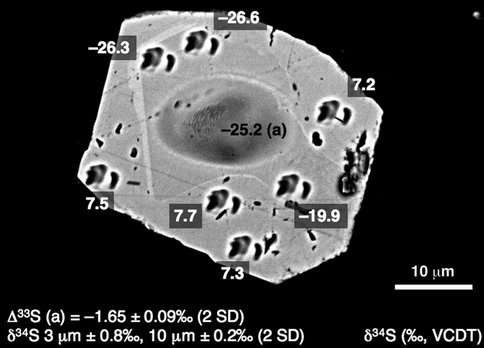2011 Annual Science Report
 University of Wisconsin
Reporting | SEP 2010 – AUG 2011
University of Wisconsin
Reporting | SEP 2010 – AUG 2011
Project 3B: In Situ Sulfur Isotope Studies in Archean-Proterozoic Sulfides
Project Summary
Using new protocols developed at WiscSIMS, we made in situ measurements of three stable isotopes of sulfur (32S, 33S and 34S) in pyrite from the Meteorite Bore Member with unprecedented small spot sizes and accuracy (Williford et al. 2011). We have found a moderate range of S-MIF (> 1‰) in authigenic pyrite before, during and after the Early Proterozoic glaciation as well as a 90‰ range of mass dependent sulfur isotope fractionation (δ34S) larger than any observed in sediments older than 700 Ma. Furthermore, abundant detrital pyrite preserved in one glacial sandstone unit from the Meteorite Bore Member exhibits a range of mass-independent sulfur isotope fractionation slightly larger than the largest published range, from 2.5 Ga sediments of the Hamersley and Transvaal Basins (> 15‰), suggesting that these detrital grains may have originated in rocks of similar age. Taken together, these data imply that the Meteorite Bore Member was deposited during the transitional interval when atmospheric oxygen had risen sufficiently for enhanced continental weathering and ocean sulfate to occur, yet remained low enough to permit the preservation of detrital pyrite and moderate S-MIF.
Project Progress
Deposition of glaciogenic sediments from the Meteorite Bore Member of the Kungarra Formation, Turee Creek Group, Western Australia coincided with the rise of atmospheric oxygen during the so-called “Great Oxygenation Event” (GOE) approximately 2.4 billion years ago. Non-zero Δ33S preserved in sedimentary sulfides is thought to originate from mass-independent sulfur isotope fractionation (S-MIF) produced by high-energy reactions in the atmosphere that would have been impossible once atmospheric oxygen concentrations rose above 10-5 present atmospheric level (PAL). As surface environments were oxidized, continental weathering of sulfide minerals would have increased seawater sulfate concentrations above the threshold at which the isotopic fractionation associated with bacterial sulfate reduction is limited. As a result, normal, mass-dependent sulfur isotope fractionation (and the range of δ34S) increased during the same time interval in which S-MIF decreases.
Using new protocols developed at WiscSIMS, we made in situ measurements of three stable isotopes of sulfur (32S, 33S and 34S) in pyrite from the Meteorite Bore Member with unprecedented small spot sizes and accuracy. A moderate range of Δ33S from –1 to 1‰ in authigenic pyrite implies an atmospheric oxygen concentration <10-5 PAL during the deposition of the Meteorite Bore member. Furthermore, abundant detrital pyrite preserved in one glacial sandstone unit from the Meteorite Bore Member exhibits a range of S-MIF (–3.6 to 11.7‰) encompassing the entire known range for the Archean. The 90‰ range of δ34S from the Meteorite Bore Member (–45.5 to 46.4‰) is larger than any reported in rocks older than 700 Ma and demonstrates that microbial sulfate reduction proceeded under non-sulfate limiting conditions. Taken together, these data imply that the Meteorite Bore Member was deposited during the interval when atmospheric oxygen was sufficiently high to permit enhanced continental weathering and delivery of sulfate to the oceans, yet low enough to permit the preservation of detrital pyrite and moderate S-MIF.
Sulfur two isotope measurements with extremely high spatial resolution reveal intragrain gradients in δ34S of 30‰ over less than 4 micrometers, sharper than any previously measured to our knowledge. Using published experimental data on sulfur diffusion in pyrite, these data allow us to constrain the thermal maturation history of the host sediments.
The sulfur isotope data we have collected from Meteorite Bore pyrites provide important information about the history of atmospheric oxygenation and its connection to global glaciation. The extreme sulfur isotopic heterogeneity revealed by in situ analyses at the microbial scale is consistent with biogeochemical models by other NAI team members suggesting that sulfate reducers and anaerobic methane oxidizers may have played an important role in atmospheric oxygenation. The analytical developments achieved at WiscSIMS have significantly refined our ability to discover and detect biosignatures in ancient sediments on Earth as well as extraterrestrial materials.
Figure 1. In situ sulfur isotope data from the ~2.4 Ga Meteorite Bore member of the Turee Creek Group, Western Australia. Vertical, dashed lines indicate the total range of mass-independent sulfur isotope fractionation present among authigenic sulfides (after Williford et al. 2011).
Figure 2. Backscattered electron image of a pyrite grain from the Meteorite Bore Member showing large (~10 mm, δ34S and Δ33S) and small (~3 mm, δ34S) SIMS analytical pits and sulfur isotope compositions. Subhedral original grain with low δ34S was overgrown by a euhedral rim with high δ34S (after Williford et al. 2011).
Publications
-
Kozdon, R., Kita, N. T., Huberty, J. M., Fournelle, J. H., Johnson, C. A., & Valley, J. W. (2010). In situ sulfur isotope analysis of sulfide minerals by SIMS: Precision and accuracy, with application to thermometry of ∼3.5Ga Pilbara cherts. Chemical Geology, 275(3-4), 243–253. doi:10.1016/j.chemgeo.2010.05.015
-
Williford, K. H., Van Kranendonk, M. J., Ushikubo, T., Kozdon, R., & Valley, J. W. (2011). Constraining atmospheric oxygen and seawater sulfate concentrations during Paleoproterozoic glaciation: In situ sulfur three-isotope microanalysis of pyrite from the Turee Creek Group, Western Australia. Geochimica et Cosmochimica Acta, 75(19), 5686–5705. doi:10.1016/j.gca.2011.07.010
- Kita, N.T., Huberty, J.M., Kozdon, R., Beard, B.L. & Valley, J.W. (2010). High precision SIMS oxygen, sulfur and iron stable isotope analyses of geological materials: Accuracy, surface topography and crystal orientation. SIMS XVII Proceedings, Surface and Interface Analysis.
- Kozdon, R., Kita, N., Huberty, J., Fournelle, J. & Valley, J.W. (2009). In situ Sulfur Isotope Analysis of Sphalerite by SIMS: Precision vs. Accuracy. Eos Trans. AGU Fall Meet. Suppl.
- Kozdon, R., Kita, N.T., Huberty, J.M., Fournelle, J.H., Williford, K. & Valley, J.W. (2010). In situ sulfur isotope analysis of sphalerite and other sulfides by SIMS: Precision vs. Accuracy. AbSciCon.
- Williford, K., Van Kranendonk, M.J., Ushikubo, T., Kozdon, R., Spicuzza, M.J. & Valley, J.W. (2011). Transitional oxygenation recorded in the Paleoproterozoic Turee Creek Group, Western Australia. Goldschmidt Conference.
- Williford, K.H., Ushikubo, T., Kozdon, R., Van Kranendonk, M.J. & Valley, J.W. (2010). ) In situ sulfur isotope evidence for low atmospheric oxygen and high seawater sulfate in Proterozoic glaciogenic sediments of the Turee Creek Group, Western Australia. Geological Society of America Abstracts with Programs, 42(5).
-
PROJECT INVESTIGATORS:
-
PROJECT MEMBERS:
Noriko Kita
Co-Investigator
Martin Van Kranendonk
Collaborator
Kenneth Williford
Postdoc
John Fournelle
Research Staff
Jim Kern
Research Staff
Reinhard Kozdon
Research Staff
Mike Spicuzza
Research Staff
Takayuki Ushikubo
Research Staff
Jason Huberty
Graduate Student
-
RELATED OBJECTIVES:
Objective 1.1
Formation and evolution of habitable planets.
Objective 4.1
Earth's early biosphere.
Objective 4.2
Production of complex life.
Objective 7.1
Biosignatures to be sought in Solar System materials


